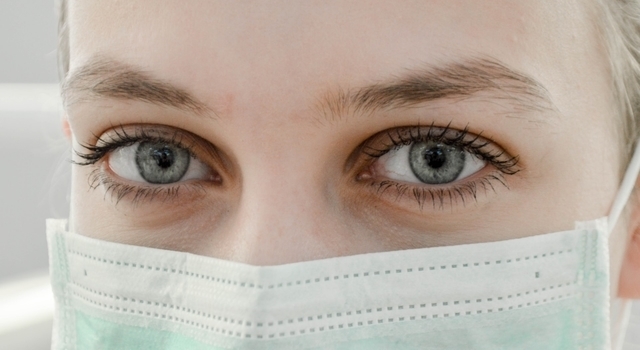 Face masks and social distancing have become the first line of defense in COVID-19 prevention.
Face masks and social distancing have become the first line of defense in COVID-19 prevention.
While these protective measures are essential to combating the virus’ spread, eye doctors are seeing an increase in dry eye cases among people who wear masks. If you are seeking relief, contact us.
What is Mask-Associated Dry Eye (MADE)?
Mask-associated dry eye (MADE) was first described by an ophthalmologist in May 2020 based on the higher rate of dry eye he was seeing in his practice among patients who wore masks. Patients with existing dry eye reported worsening symptoms when wearing a mask.
When a face mask doesn’t fit securely, it can push air from the nose and mouth upward, onto the eyes, causing the tear film — the liquid layer that coats the eyes’ surface — to evaporate more quickly. This leads to MADE.
Dry eye leaves the eyes feeling sore, gritty, dry and irritated. Left untreated, dry eye can cause damage to the cornea.
There are many causes of dry eye, including eye and health conditions, age, gender and certain medications. Insufficient blinking when looking at a digital device or book, poor indoor air quality and pollution can all play a role. Situations that increase how quickly the tear film evaporates can quickly and significantly dry the eye’s surface, leading to more pronounced symptoms.
What Causes Dry Eye When Wearing a Mask?
Wearing a face mask significantly reduces the spread of air when breathing out from the mouth and nose. Instead of moving out, the air moves upwards towards the eyes’ surface. This forces a stream of air over the surface of the eye, causing the tears to evaporate more quickly.
This is the same reason that eyeglasses fog up when wearing a mask.
When masks are worn for long periods of time, this repeated evaporation may lead to dry spots on the eyes’ surface.
How to Prevent or Alleviate MADE?
Here are some simple measures to help reduce dry eye while wearing a mask:
- Ensure your mask fits well, and consider taping the top edge to prevent air from rising from your mouth toward your eyes.
- Limit your time in air-conditioned or heated environments when possible. Also, take regular breaks from digital devices.
- Consult your eye doctor, who will examine your eyes and prescribe the best treatment.
Having to wear a face mask to prevent COVID-19’s spread may cause dry eye, but relief is available. Contact The Dry Eye Spa and Treatment Center at Peters Family Eyecare if you are experiencing dry eye symptoms. We will determine the underlying cause of your dry eye and offer you the best solution so you can get back to having comfortable eyes and vision.
The Dry Eye Spa and Treatment Center at Peters Family Eyecare serves patients from Bryan, Fort Wayne, Indiana , Toledo and , throughout Ohio.
